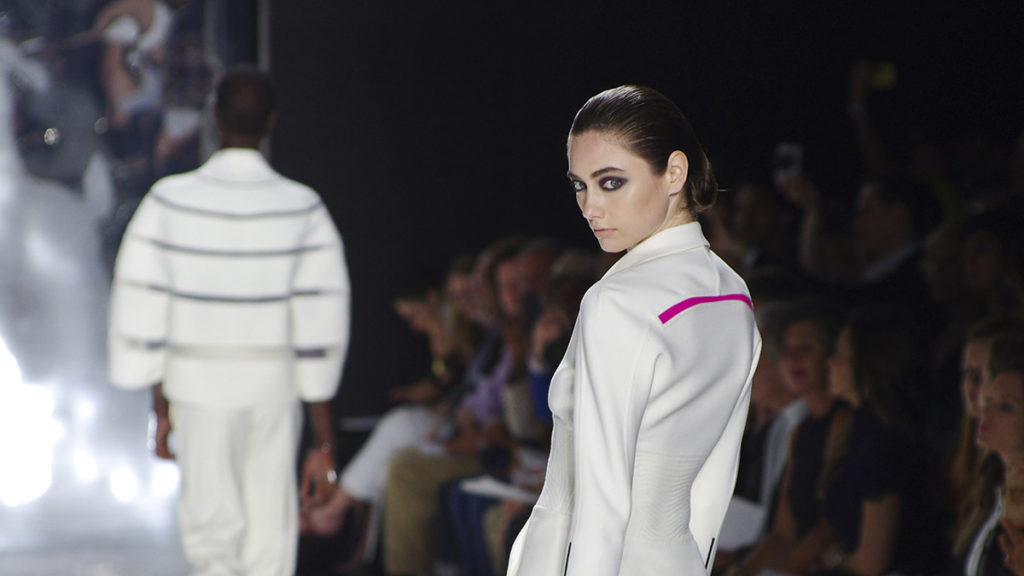What is Fashion Technology, or Fashion Tech?
Fashion Tech is just an abbreviation for fashion technology. Both terms can describe any technology that intersects with the fashion industry to produce a unique result that is different from how that technology would intersect with any other industry.
Examples might be how blockchains are being used to trace fibers for supply chain mapping, algorithms that are used to change garment manufacturing patterns on the fly, or simply the systems of hand movements used to make different types of garments with knitting needles.
Up until around 2008, outside of industrial manufacturing equipment, the most prevalent technology in the fashion industry was, perplexingly, the fax machine. We’ve come a long way in just a few years. E-commerce exploded, supply chain problems have driven supply chain innovations leading to greater transparency both for insiders and consumers, and even blockchains are starting to be utilized in normal operations by more than a handful of experimental brands.
Fashion itself, clothing, is arguably humanity’s oldest technology. We were weaving things together to protect ourselves at the dawn of our evolution. Perhaps weaving existed before homo sapiens even existed, if you consider that neanderthal art has been found and our other predecessor cousins the denisovans, with whom we have a tremendous amount of genetic material in common, seem to have been only slightly behind us in intelligence potential.
It’s expanded, of course. Now fashion technology includes mechanical engineering, materials science, dying techniques, weaving techniques, behavior science, e-commerce, augmented reality, virtual fashion, and a thousand other systems. This creates a complex ecosystem, and perhaps multiple overlapping ecosystems is a better way to start to mentally grasp that complexity.
The word “technology” has a Greek etymological origin: Tekhnē, meaning “art” or “craft”; and -logia, meaning “system”: Tekhnēlogica… Craft System
In a field with such a name, you would expect a lot of futurists, but the problem tends to be specialization. There is only so much you can learn in a career, and most people in the fashion business tend to gravitate toward “soft systems:” design and human psychology.
When Charles Beckwith penned his first op-ed for Business of Fashion in 2017, he was surprised that no one else was really writing about blockchain yet, and least of all critically. The first fashion blockchain article was meant as a warning about what at the time was looking like a lot of hype and vaporware. The potential was there, but everything was clearly still experimental, and the shysters were circling to sell the dream with “assembly required” in the tiny fine print. Fashion blockchain startups have come a long way since then. The Lukso fashion blockchain remains Charles’ favorite in the race, particularly for its focus on “the new creative economy.”

The Fashion TecH Guru, Your Fashion Technology Advocate
Up to that point, when he wrote the first fashion blockchain article for BoF, consulting on fashion technology was more a hobby than work. Designer friends would be approached by vendors selling expensive systems with big claims, and Charles would be asked to take a look at them and help the designers and merchants understand the Pros and Cons.
Some, like the Shopify platform, got a big immediate thumb’s up: very helpful for a brand. Others, particularly many of the problematic early fit-tech startups, were a definite pass. Sometimes a designer would know there was a problem with what they were being pitched, but just couldn’t articulate it for themselves, like when a startup was selling “3D knitting” solutions. What was wrong with it? All knitting is three-dimensional. So, now this work is a bit more formalized, and Charles continues to help clients sort through the noise.
Charles Beckwith has 35,000+ hours of media production, online media, marketing, and SEO experience. He has led dozens of companies and projects involving everything from live media broadcasts to interactive art exhibitions with 3,000+ simultaneous participants to events with 25,000+ attendees to directing Off-Broadway to enterprise business development. He has also interviewed over 300 fashion designers and brand managers for the American Fashion Podcast and photographed 750+ runway shows and presentations in New York and Milan.
He has contacts at the highest levels of the fashion, entertainment, and technology industries. His media projects have scored an incalculable number of impressions, and his business development efforts have generated several hundred million dollars in value for clients and partners. He brings together immense knowledge of fashion, media, and technology with his communication and writing expertise to analyze and report on “what’s next in fashion technology,” to support clients who need help navigating the technological landscape.
Book a consultation here: https://clarity.fm/fashiontechguru/expertise/fashion-technology

